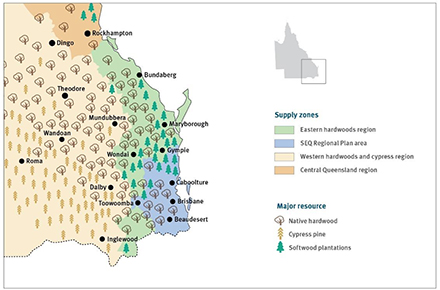A landmark study has found that state forests deliver better long-term social outcomes than national parks in South and Central Queensland. The Indufor-Natural Capital Economics study found – ‘State forests…would have a slightly superior outcome in terms of carbon sequestration and storage in forest and offsite storage and substitution impacts, in comparison to formally protected forests, over the longer term.’ Source: Timberbiz
The cost-benefit study was commissioned by the South and Central Queensland Regional Forestry Hub with funding from the Australian Government, Department of Agriculture, Fisheries and Forestry.
The study found that timber harvesting is not considered one of the common or significant threats to forest biodiversity or the environment in Australia.
Further it concluded sustainable timber harvesting supports a broad range of socio-economic benefits and that the cessation of timber harvesting, and transfer from multiple use forests to national parks and conservation reserves, is unlikely to result in any climate change mitigation benefits.
It also found that the cessation of timber harvesting, and transfer from multiple use forests to national parks and conservation reserves, may result in lower net social benefits over the longer term.
The study also concludes the net benefit for state forest management in South and Central Queensland equated to $1.2 billion in additional social benefits over the next 100 years, or 30 per cent higher than if the forests were national parks. The study compared management outcomes in state forests and national parks using cost benefit analysis.
“The study conducted by Indufor and Natural Capital Economics is a best practice approach to comparing management outcomes in state forests and national parks using cost-benefit analysis,” Timber Queensland Chief Executive Officer Mick Stephens said.
“By taking into account the broad range of goods and services provided from state forests in the region, it was found that they deliver higher net social benefits over the range of discount rates and time periods evaluated.”
“The median net benefit from state forest management was equal to an extra $1.2 billion in social benefits over the next 100 years, or 30 per cent higher than if they were national park.”
Mr Stephens said the result was significant and demonstrated the enormous value from the multiple-use management of state forests.
“These forests deliver a broad range of social outcomes, including the provision of biodiversity, recreation, timber production and lower emissions through the carbon captured in forests and in harvested wood products,” Mr Stephens said.
“Selective harvesting of timber is also undertaken in accordance with the Queensland Parks and Wildlife code of forest practice, which provides state revenue to help offset management costs and pay for fire prevention, recreation assets and biodiversity protection.
“Public forest decision making in Australia is often cast in a narrow land use paradigm that the only way to look after native forest and biodiversity is to lock it up in formal reserves. This is an outdated approach which fails to recognise the benefits from actively managing forests for multiple outcomes and ecosystem services, which this study shows,” he said.
“The study also identified the importance of engagement with First Nation peoples on the management of public native forests and recognition of indigenous cultural values.”
Australian Forest Products Association CEO Ross Hampton said the research clearly demonstrated the higher carbon value and community benefits derived from native forests where sustainable timber harvesting takes place.
“Not only is biodiversity protected, but these forests also allow broader recreation activities, while the harvested timber goes on to create quality, sustainable and essential products where carbon is locked up, thereby fighting climate change,” Mr Hampton said.
“Sustainable native forestry is critical to Australia. It’s critical in terms of carbon sequestration, to provide sustainably sourced timber and fibre products, and is socially and economically critical to the communities it underpins.
“This study clearly shows the beneficial triple bottom line outcomes from the multiple-use management of state native forests at a regional level,” he said.
The report can be found at https://3c785422-7e5f-4697-8812-253f6969c073.usrfiles.com/ugd/3c7854_5c54d42189d242afa894b66dbbcf830a.pdf







